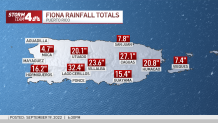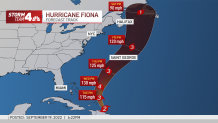Hurricane Fiona strengthened to a Category 2 storm after moving out over the Atlantic and could further intensify (possibly to Category 4) just days after it devastated a blacked-out Puerto Rico with life-threatening floods and catastrophic rainfall that upended the power grid, triggered mudslides and had millions in the U.S. shouting out prayers for the island.
Puerto Rico endured life-threatening floods for a second straight day Monday, swamped in more than 2 feet of rain from Fiona, and pummeled the Dominican Republic after making a second landfall there around 3:20 a.m. ET.
Hurricane conditions continued to batter the Dominican Republic as of the National Hurricane Center's 8 p.m. update, with maximum sustained winds of 105 mph reported as the center swirled about 130 miles southeast of Grand Turk Island. A hurricane warning remains in effect for Turks and Caicos, while a hurricane watch remains in effect for the coast of the Dominican Republic from Cabo Caucedo to Puerto Plata.
The tropical storm warning has expired for Puerto Rico, where the devastating toll remains yet to be tallied. The rain finally, mercifully, came to an end for the most part Monday evening for Puerto Rico and the Dominican Republic, although scarce isolated downpours remain possible as smaller bands of rain rotate through the area. It also means that the threat for additional major flooding will come to an end as well, but flash flood warnings remained for the center part of the island.
Get Connecticut local news, weather forecasts and entertainment stories to your inbox. Sign up for NBC Connecticut newsletters.
When all is said and done, some southern areas of Puerto Rico could see more than 30 inches of rain, with up to 20 inches of rain in northern ones, as the threat of deadly mudslides still looms large. Some spots had seen at least 20 inches before dawn Monday in New York.

President Joe Biden declared a state of emergency for the U.S. territory ahead of the storm, while the governor of Puerto Rico, as the worst of it hit, described "catastrophic" damages as the island plunged into darkness.
Luma, the company that operates power transmission and distribution, said bad weather, including winds of 80 mph, had disrupted transmission lines, leading to “a blackout on all the island.”
“Current weather conditions are extremely dangerous and are hindering our capacity to evaluate the complete situation,” it said, adding that it could take several days to fully restore power.
New York Gov. Kathy Hochul pledged 100 state troopers and medical supplies to help.
Fiona made landfall in Puerto Rico Sunday as a Category 1 hurricane and made a second landfall in the Dominican Republic early Monday at similar strength. Storm surges raised water levels by as much as 3 to 5 feet above normal tide levels in parts of the Dominican Republic, before the storm moved on by Monday evening as a Category 2 hurricane. While the center of the storm will move away from the Dominican Republic, up to 5 more inches of rain could fall on the area that has already had building destroyed by the powerful storm.
As of NHC's 8 p.m. update, Fiona was moving toward the northwest and is expected to continue that motion through Monday night, followed by a turn toward the north-northwest on Tuesday and to the north on Wednesday. In addition to the hurricane warnings and watches issued, a tropical storm warning is in effect for southeastern Bahamas.
On the current track, the center of Fiona will move over the southwestern Atlantic through Monday, before it is expected to pass near or to the east of the Turks and Caicos on Tuesday. Hurricane-force winds extend outward up to 30 miles from the storm's center, while tropical-storm-force winds extend up to 140 miles from the center.
A gust of 98 mph was recorded in Samana El Catey, Dominican Republic, as the hurricane blew through earlier. Parts of the country could see more than 20 inches of water from Fiona, while up to 8 inches are expected for Turks and Caicos.
Strengthening is expected over the next few days after Fiona emerges over the southwestern Atlantic, and it is expected to become a major hurricane by Wednesday, NHC says. It could reach up to a Category 4 storm at that time, though it will be far west of the Bahamas by then. It could remain a Category 1 hurricane when it makes landfall once again Saturday night — up in Newfoundland, Canada.
As of now, it poses no threat to any part of the mainland U.S., although large swells will bring high surf to tri-state area beaches by the end of the week.


